Asus has been building the ROG Ally for 5 years and here are the hideous prototypes to prove it
The ROG Ally would have been released whether the Steam Deck existed or not... just probably not quite so soon.

Asus has been at pains to make clear that it was making the ROG Ally handheld gaming PC long before Valve launched its Steam Deck. Sure, it's an AMD-powered PC console, just like Valve made, but Asus has released an image of a selection of different prototype models from the five years of iteration before settling on the Ally design. Just like Valve released.
The company has just unveiled the ROG Ally ahead of its full launch on May 11 this year, and we've been talking with Asus about the machine itself, and how it fits into the burgeoning handheld gaming PC market.
But would the Ally exist were it not for the Steam Deck, we asked?
"Yes, it would still exist," Galip Fu, Asus' global marketing director tells us, "but perhaps not as soon as 2023. Valve has been a central figure in the PC gaming industry for decades and has a special place in the hearts of gamers, including us.
"While we have had the design for a Windows-based PC gaming handheld device ready for some time, we were waiting for something that could offer the ultimate gaming experience—something that could meet the performance demands of gamers."
And that's where these sometimes grim-looking prototypes come in—like, I mean what the hell is this meant to be?! It looks like some sort of 1950's pseudo futuristic TV, and I have no idea whether that's a stand or where you're meant to be holding the device.

And this? Is this prototype literally just a phone with a lump of brown modelling clay attached (my brain keeps going towards excrement, but I live with a pair of toddlers so that's a given)?
Keep up to date with the most important stories and the best deals, as picked by the PC Gamer team.


Steam Deck review: Our verdict on Valve's handheld PC.
Accessories for the Steam Deck: Get decked out
Steam Deck availability: How to get one.
Steam Deck battery life: What's the real battery life of the new device?
Steam Deck - The emulation dream machine: Using Valve's handheld hardware as the ultimate emulator.
It certainly does look like Asus needed Valve's encouragement to actually push forward with this idea, because it sure looks like it was going to a bad place design-wise. But it's also needed the hardware, because five years ago we were nowhere near having the right silicon that could deliver gaming and battery life in that form factor.
Hell, we were a couple of years away from even the Alienware UFO concept that seemed like a good idea at the time, even if it didn't have the performance and was expecting to cost well over a thousand dollars.
"The Steam Deck's introduction in 2021 was a great encouragement for us," says Fu. "It inspired us to accelerate our collaboration with AMD to develop something even more advanced—something that is powerful and efficient enough for modern PC handheld gaming."
And the AMD Z1 and Z1 Extreme chips look like the right kind of hardware to be sticking into a handheld gaming PC, however you shape the outsides. At the low end you're talking about far more GPU power than the Steam Deck can offer, and at the top end of 8.6 TFLOPS, with the Z1 Extreme, you're looking at desktop graphics card performance in the order of an RX 6600.
Though we don't know what that will do in terms of thermals and battery life just yet. Or even what it will do to the price. I struggle to believe the top-tier Ally handheld will stick to that "for sure… below $1,000" price point. I guess we'll have to wait for the ROG Ally's May 11 launch to find out.

Dave has been gaming since the days of Zaxxon and Lady Bug on the Colecovision, and code books for the Commodore Vic 20 (Death Race 2000!). He built his first gaming PC at the tender age of 16, and finally finished bug-fixing the Cyrix-based system around a year later. When he dropped it out of the window. He first started writing for Official PlayStation Magazine and Xbox World many decades ago, then moved onto PC Format full-time, then PC Gamer, TechRadar, and T3 among others. Now he's back, writing about the nightmarish graphics card market, CPUs with more cores than sense, gaming laptops hotter than the sun, and SSDs more capacious than a Cybertruck.

